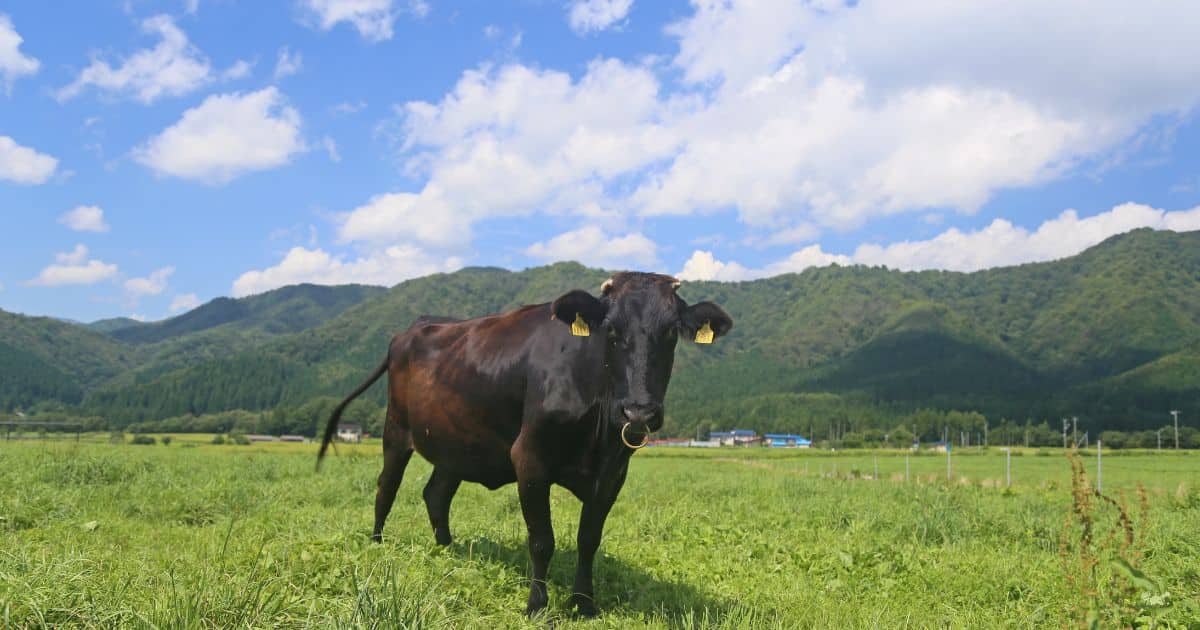Wagyu beef originates from Japan and is one of the most prized and sought-after meats in the world. What makes it so special is the extensive marbling that creates an unparalleled buttery tenderness and mouthwatering flavor This exceptional quality can only be achieved through traditional Japanese farming practices that focus on raising happy and healthy cows In this article, we will explore how wagyu cattle are raised and why it produces some of the best beef on the planet.
A Stress-Free Upbringing
The key to tasty wagyu beef is ensuring the cattle live a pampered, stress-free lifestyle from birth through slaughter. Stress hormones like cortisol toughen the meat, so every effort is made to keep wagyu cows relaxed and content.
Young wagyu calves stay with their mothers on small family farms until about 9 months old. They are bottle fed by hand and even outfitted with coats in cold weather. The farmers give each cow a name instead of a number to foster a sense of individuality.
When they reach 10 months, the calves are sold to specialist feeding farms. Here they continue to receive personal care and attention in an uncrowded, tranquil environment. The clean, quiet barns house only 4-5 cattle per pen, giving them plenty of space.
Wagyu farmers refrain from using growth hormones or stimulants that could cause anxiety. Their goal is to promote steady, natural development resulting in well-marbled beef The more marbling, the more succulent and flavorful the meat.
Gourmet Feed for Gourmet Beef
The wagyu diet is another essential element in producing the signature rich, buttery flavor. Farmers craft nutritionally balanced meals using top-quality ingredients like alfalfa, corn, barley, soybean and wheat. Some even import special feed from overseas.
The cattle are fed up to 3 times daily and gain around 25 pounds each day Their feed is adjusted regularly to ensure proper fat marbling based on monthly weigh-ins. Wagyu farmers will add supplements like brewer’s grain, vegetable oil and omega fatty acids to further boost marbling.
This tailored nutritional program avoids health issues like metabolic disorders and liver abnormalities that cause inferior beef. By age 2-3 years, wagyu cattle achieve the ideal 50% fat content ratio for perfectly tender, well-marbled meat.
Pampering Promotes Prime Cuts
The wagyu pampering doesn’t end with feeding. Farmers employ various techniques to keep their cattle relaxed and muscles loose. For example, they often brush the cows to increase blood flow and massage out tension.
Some farmers even play soothing music in the barns to maintain a calm environment. And of course the cows aren’t subject to strenuous activity that could make their meat tough. This spa-like treatment ensures supple, fine-textured beef cuts after slaughter.
Traditional Techniques Yield Tasty Rewards
Raising wagyu beef requires far more time, effort and expense than conventional methods. But it’s the only way to consistently achieve the exquisite marbling, buttery texture and amazing flavor that makes wagyu the most prized beef worldwide. By adhering to time-honored traditions like pampering, hand-feeding and stress reduction, Japanese farmers have perfected the art of cultivating delicious wagyu.
While wagyu accounts for only a tiny fraction of beef produced globally, its immense popularity shows no signs of waning. As more people discover this melt-in-your-mouth delicacy, the market for real-deal Japanese wagyu continues to grow. For beef lovers, the extra cost is worthwhile to enjoy this truly exceptional eating experience.
Frequently Asked Questions About Wagyu Beef
Here are answers to some common questions about wagyu cattle and beef:
What makes wagyu beef so special compared to other types of beef?
The extensive marbling from ample intra-muscular fat is what gives wagyu its trademark buttery, velvety texture and rich flavor. This high degree of marbling is only possible through traditional Japanese husbandry focused on health and reducing stress.
Why is wagyu beef more expensive than other beef?
It’s more expensive because the cattle require far more care and higher quality feed. Each wagyu cow costs around $30,000 and takes longer to reach slaughter weight. Their feed is tailored to promote fat marbling, which requires top-notch ingredients.
What do wagyu cattle eat?
Wagyu are fed a customized high-energy diet with ingredients like alfalfa, corn, barley, soybean, wheat and rice straw. Farmers adjust the feed to control marbling. Supplements like brewer’s grain and vegetable oil are added too.
How are wagyu cattle raised?
They are raised with a pampered, stress-free lifestyle. Calves stay with mothers initially, then move to spacious pens at feeding farms. Farmers give each cow personal attention and avoid growth hormones. Cattle are brushed and massaged too.
Where does real wagyu beef come from?
Authentic wagyu comes from Japan. The four Japanese breeds used are Kuroge (Black), Akaushi (Brown), Tankaku (Shorthorn) and Mukaku (Polled). Most exported wagyu is crossbred with Angus or other breeds.
What’s the difference between Kobe beef and wagyu beef?
Kobe beef refers specifically to wagyu from the Tajima bloodline raised in Kobe, Japan. But all Kobe is wagyu, while only some wagyu is Kobe. Kobe is most famous type of wagyu worldwide.

What is aged Wagyu?
Fresh beef consists of muscle fibres which are held together by collagen tissues. The natural collagen is one of the reasons why steak toughens during the cooking process. To avoid such toughening, abundant fat marbling and dry ageing are required. During the ageing process, natural enzymes will cause the collagen to break down, leaving only the tender meat fibres and the marbling. Water in the beef will evaporate during the ageing process while the flavour intensifies.
What Makes Wagyu Cows So Unique?
Wagyu cows originate from Japan, a country that was particularly isolated from the world between the 17th and 19th centuries. As a result of this seclusion, cows were not able to crossbreed, and so most Japanese cows retain unique genetic qualities. Early on in the 20th century however, the country’s cows were permitted to crossbreed with foreign cattle. By 1944, researchers categorized Japanese cattle into the four breeds the country is known for today.
